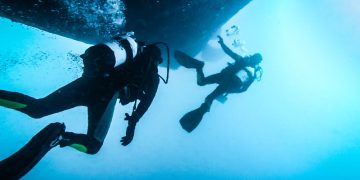A new report by Nautilus International and the International Organization of Masters, Mates & Pilots (MM&P) has revealed an alarming decline in merchant fleets and seafarer numbers across NATO member nations, potentially undermining the alliance’s ability to respond to global conflicts and crises.
The report “NATO Member States’ National Merchant Fleet and Seafarers: Implications for maritime security and resilience” reveals and highlights a troubling decline in merchant fleets and seafarer numbers among NATO member countries.
According to the report, this trend threatens to weaken the alliance’s ability to effectively respond to global conflicts and crises, potentially undermining the core Article Five commitment that an attack on one member is an attack on all.
Availability of ships: Current status and challenges
Among NATO member states, the United States has the largest number of registered ships, followed by Norway, Italy, Greece, the Netherlands and Türkiye. However, the combined merchant fleet capacity of NATO countries is significantly smaller than China’s. As of 2023, China’s fleet reached 127,487 thousand DWT, while Greece, the largest within NATO, had 58,940 thousand DWT.
All merchant ships must be registered in a flag state, which can indicate the health of a country’s maritime sector. Many large vessels are flagged in countries different from the owner’s nationality, known as flags of convenience offering lower taxes, fewer regulations and cheaper labor.
For example, in 2022, 49% of Japanese-owned ships were registered in Panama and Greek-owned ships were widely registered in Liberia and the Marshall Islands.
Furthermore, over 70% of global ship capacity in 2022–2023 was registered under foreign flags. The top registries include Panama, Liberia and the Marshall Islands, with only a few national registries like China, Greece, and Japan making the top 10 Vessel registration is especially common in developing countries and small island states due to cost advantages.
Although international law (UNCLOS) requires a “genuine link” between a ship and its flag state, there’s no global agreement on what this means. A 1986 UN convention tried to clarify this but hasn’t entered into force.
Additionally, the UK has experienced a sharp decline in its flag vessels, alongside a significant reduction in British seafarers. Despite policy measures introduced in 2000 to support flag growth and skills development, these initiatives have merely stabilised rather than reversed the decline.
“The tonnage tax policy has not been effective in achieving its goals of growing the UK flag and UK seafarers” Mark Dickinson, General Secretary, Nautilus International, highlighted.
Availability of seafarers: Trends and gaps
The Philippines, Russia, Indonesia, China and India are the largest suppliers of ratings and officers on merchant ships worldwide, with many seafarers recruited through crewing agencies or ship management firms to work on foreign-flagged vessels, often flags of convenience.
Officer supply grew rapidly between 2013 and 2016 due to rising wages and career prospects but slowed to 0.8%-0.9% annual growth by 2021. Contributing factors include stagnant wages, increased administrative burdens and criminalization risks, early retirements in officers’ 50s, automation limiting career progression, and reduced demand following oil price crashes, offshore sector downturns, and the COVID-19 pandemic.
Regionally, the EU shipping industry supported approximately 2 million jobs in 2018, employing around 550,000 seafarers (210,000 officers and 345,000 ratings), with 38% EU/EEA nationals and 62% non-EU/EEA. By the end of 2020, EU Member States issued certificates of competency to about 189,000 masters and officers, with an additional 128,000 holding non-EU certificates endorsed by EU states.
However, reliable and standardized data on active seafarers remain lacking, as certification databases often cannot distinguish between active and inactive personnel.
Furthermore, globally, there are an estimated 1.89 million seafarers, with NATO countries accounting for about 421,000 (roughly 22%). In the U.S., out of nearly 60,000 seafarers listed, only around 12,000 are qualified and available for unlimited tonnage ocean-going vessels.
This shortage of qualified seafarers presents a significant challenge for NATO’s ability to effectively project power, sustain military operations and respond to global crises, highlighting the urgent need for investment in maritime workforce capabilities, the report highlights.
Recommendations
Policy Reforms and Coordinated Governance
- Enhance targeted State aid to incentivise shipowners to support national policy objectives that aim to grow the national fleet and national maritime skills base.
- Link all State aid directly to training and employment outcomes i.e. requiring a minimum share of national seafarers on ships enrolled in support schemes.
- Enhance support for maritime education and training to ensure a skilled workforce, e.g. 100% of the costs of training seafarers to be provided.
- Restrict State aid eligibility to vessels under national (first) registries, excluding those registered in countries designated as flags of convenience.
- Develop a coordinated governance framework among NATO Member States’ to ensure sustainable maritime employment and competitiveness.
- Require the use of NATO-flagged vessels in existing trade agreements and ongoing negotiations amongst NATO Member States’, in accordance with the security exceptions of Article XXI of the GATT Agreement.
Strengthening the Genuine Link and Responsibilities of a Flag State
- Reaffirm and enforce the principle of a genuine link between ships and their flag states, aligning with Article 91 of the UN Convention on the Law of the Sea.
- Reaffirm and enforce the principle of the duties of a flag State, aligning with Article 94 of the UN Convention on the Law of the Sea.
- Review the UN Convention on Conditions for Registration of Ships (1986), with a view to promoting ratification and enforcement of its requirements.
- Implement coordinated efforts among flag States, port States, and industry stakeholders including social partners to close gaps exploited by flags of convenience.
Investment in Maritime Capabilities
- Increase investment in national merchant marines and national maritime professionals.
- Boost the number of qualified national seafarers and national-flagged vessels.
- Develop strategies to retain and attract talent in the maritime sector.
Enhancing Data Collection and Analysis
- Improve data collection methods to address fragmentation in ship ownership and registration.
- Use comprehensive data to develop informed policies and strategies for the maritime sector.
Strengthening NATO’s Maritime Resilience
- Develop contingency plans to overcome the reliance on foreign-flagged ships/flags of convenience for military logistics and supply chains.
- Enhance cooperation among NATO Member States’ to pool maritime resources and capabilities with due regard for the sovereignty of all States.
































































